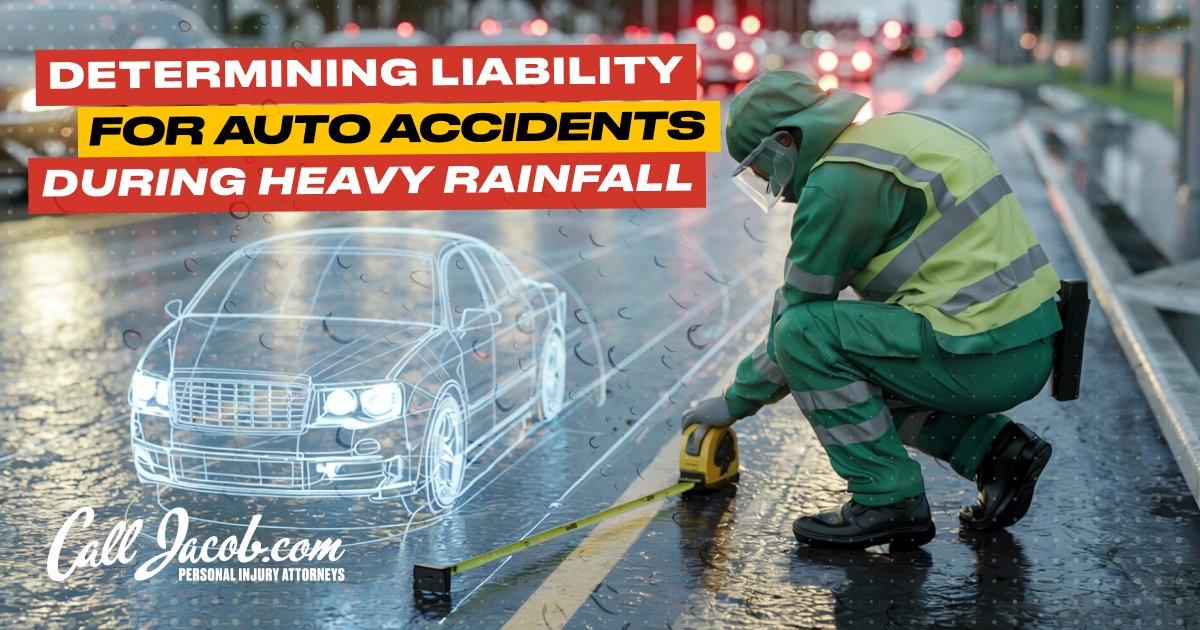Los Angeles is no stranger to heavy rainfall, which creates hazardous driving conditions and increases the likelihood of auto accidents. After a car accident due to rain, it can be challenging to determine liability accurately. The skilled team at the Law Offices of Jacob Ermani, are experts at navigating all of the facets that come from an accident and its cause. Lets explore the key aspects of determining liability for auto accidents that occur during heavy rainfall.
Contributing Factors to Accidents in Heavy Rainfall
Several factors contribute to rain accidents during heavy showers. Some of the most common include:
- Reduced visibility: Rain can significantly impact a driver’s ability to see road signs, lane markings, and other vehicles, especially at night.
- Slippery roads: Wet pavement reduces tire traction, increasing the likelihood of skidding or hydroplaning. Sudden braking can cause a loss of control, leading to collisions.
- Hydroplaning: Occurs when a vehicle’s tires lose contact with the road surface due to a layer of water, causing the driver to lose steering control.
- Speeding: Many drivers fail to adjust their speed to match road conditions, making it harder to stop or maneuver safely in wet conditions.
- Inadequate vehicle maintenance: Worn-out tires, ineffective windshield wipers, and faulty brakes exacerbate risks during heavy rainfall.
- Driver negligence: Distracted driving, aggressive lane changes, or failure to turn on headlights in poor visibility contribute to accidents.
Identifying which of these factors played a role in an accident is essential in determining liability.
Legal Considerations for Determining Liability
Liability is typically assessed based on negligence in auto accident cases involving heavy rainfall. The legal system considers whether a driver exercised reasonable care under the circumstances.
Some key legal considerations include:
- Duty of care: Every driver has a legal responsibility to operate their vehicle safely, considering road conditions.
- Breach of duty: If a driver fails to adjust their driving to match adverse weather conditions (e.g., driving too fast for the conditions), they may be considered negligent.
- Causation: Even if an accident due to weather conditions occurs, a driver could still be held liable if their actions directly caused the collision.
- Evidence collection: Police reports, witness statements, dashcam footage, and road conditions at the time of the accident all play a role in determining liability.
After the accident, never try to determine fault by yourself, and make sure to take photos of the accident.
Factors Influencing Liability Determination
When determining fault in a car accident that occurred in heavy rainfall, multiple factors are considered:
- Driver behavior: Did the driver take reasonable precautions such as reducing speed, increasing following distance, and using headlights?
- Traffic laws and regulations: Was the driver following posted speed limits and traffic signals? In some cases, speed limits may be deemed unsafe under heavy rainfall.
- Road conditions and maintenance: Poorly maintained roads, potholes, or inadequate drainage all contribute to accidents. In such cases, municipalities or road maintenance entities might be liable.
- Vehicle condition: Were the tires, brakes, and windshield wipers in good working condition? A driver who fails to maintain their vehicle correctly may bear partial responsibility for an accident.
- Third-party involvement: If another driver’s reckless behavior contributed to the accident, they may share liability.
Since each case is unique, legal professionals analyze all of these factors to establish fault.
Comparative Fault in Auto Accidents During Heavy Rainfall
Many states follow comparative fault rules, meaning more than one party can be held liable for an accident. The state of California follows what is called a pure comparative negligence system, meaning a driver can recover damages even if they were partially at fault, but their compensation is reduced by their percentage of fault.
For example, if a driver speeds in heavy rain and collides with another vehicle that fails to use headlights, both drivers might share liability. In such cases, insurance companies and courts determine each party’s percentage of fault before awarding the cost of damages. Under pure comparative negligence, someone can be 99 percent at fault in an accident and still file a claim.
Mitigating Risk and Preventing Accidents in Heavy Rainfall
While determining liability is crucial after an accident, taking preventive measures helps reduce the likelihood of crashes in heavy rainfall. Drivers can minimize risk by:
- Reducing speeds: Driving slower than the posted speed limit in rainy conditions improves control and reaction time.
- Increasing following distance: Keeping at least a five-second gap between vehicles allows for safer stopping.
- Using headlights: Turning on headlights, even during the daytime, improves visibility.
- Avoiding sudden maneuvers: Abrupt braking, acceleration, or sharp turns can cause a loss of control.
- Checking tire tread and pressure: Proper tire maintenance helps maintain traction on wet roads.
- Replacing windshield wipers regularly: Clear visibility is crucial in heavy rain.
- Avoiding distracted driving: Keeping full attention on the road helps drivers react to hazards more effectively.
By following these precautions, drivers can significantly reduce the chances of an accident occurring in adverse weather conditions. It’s also important to know what to do after an auto accident.
Contact The Law Offices of Jacob Emrani Today
Whether you were a victim of another driver’s negligence or need assistance proving fault, our team is here to assist you every step of the way. The experienced legal team at The Law Offices of Jacob Emrani will help you navigate the complexities of personal injury claims, ensuring that you receive the compensation you deserve.
Schedule a Free Consultation
Don’t let the complexities of liability in bad weather prevent you from seeking justice. Contact The Law Offices of Jacob Emrani today for a free case evaluation. Call us at (888) 912-7115 for a no-cost case evaluation.
We fight for your rights, making sure that you get paid for damages, medical expenses, and other losses after an accident. Let our experienced attorneys advocate for you and help you get back on the road.



